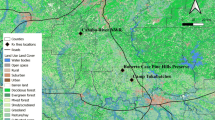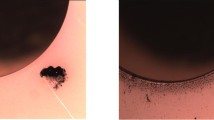Abstract
A unique airborne smoke sample package (ASSP) for determining the smoke yield of large fires has been developed. The uncertainty in the average smoke yield at the 95% confidence interval is about ±7% of the average of three repeat measurements. The ASSP, which weighs less than 4 kg, is light enough to be flown suspended below a tethered helium-filled balloon or attached to a small radio-controlled aircraft. Measurements are made by flying the sampling equipment into a fire's smoke plume. Additional smoke plume measurements that can be made with the ASSP include particle size distribution using a cascade impactor, smoke agglomerate structure using transmission electron microscope (TEM) grids, and polycyclic aromatic hydrocarbons (PAHs) analysis using various sorbent tubes. The application of the ASSP in measuring laboratory and large outdoors petroleum pool fires is discussed. Smoke yield values measured in field burns of Louisiana crude oil range from 0.080 to 0.137, and the primary sphere diameter of the agglomerates is as large as 0.15 µm.
Similar content being viewed by others
References
Evans, D., Baum, H., McCaffrey, B., Mulholland, G., Harkleroad, M. and Manders, W.,Combustion of Oil on Water, NBSIR 86-3420, U.S. Department of Commerce, National Bureau of Standards, Gaithersburg, Md., November 1987.
Evans, David D., “In-Situ Burning of Oil Spills,”Workshop Proceedings of Alaska Arctic Offshore Oil Spill Response Technology, NIST SP 762, edited by Nora H. Jason, U.S. Department of Commerce, National Institute of Standards and Technology, 1988, pp 47–95.
Allen, Alan A., “Contained Controlled Burning of Spilled Oil During the Exxon Valdez Oil Spill,”Proceedings of the Thirteenth Artic Marine Oilspill Program Technical Seminar, Environment Canada, 1990, pp 305–313.
Evans, D.D., Walton, W.D., Baum, H.R., Notarianni, K.A., Lawson, J.R., Tang, H.D., Keydel, K.R., Rehm, R.G., Madrzykowski, D., Zile, R.H., Koseki, H. and Tennyson, E.J., “In-Situ Burning of Oil Spills: Mesoscale Experiments,”Proceedings of the 15th Arctic and Marine Oilspill Program Technical Seminar, Environment Canada, Ontario, 1992.
Benner, B.A., Jr., Bryner, N.P., Wise, S.A., Mulholland, G.W., Lao, R.C. and Fingus, M.F, “The Polycyclic Hydrocarbon Emissions from the Combustion of Crude Oil on Water,”Environmental Science and Technology, 24, 1990, pp. 1418–1427.
Ward, D.E., Sandberg, D.V., Ottmar, R.D., Anderson, J.A., Hofer, G.C. and Fitzsimmons, C.K.,Measurements of Smoke From Two Prescribed Fires in the Pacific Northwest, Seventy-Fifth Annual Meeting of the Air Pollution Control Association, 1982 (available from D.E. Ward, U.S.D.A. Forest Service, Intermountain Research Station, Missoula, Mont.)
Dod, R.L., Brown, N.J., Mowrer, F.W., Novakov, T. and Willimson, R.B., “Smoke Emission Factors from Medium-Scale Fires, Part 2,”Aerosol Science Technology, 10, 1989, pp. 20–27.
Radke, L.F., Hegg, D.A., Lyons, J.H., Brock, C.A., Hobbs, P.V., Wiess, R. and Rasmussen, R., “Airborne Measurements on Smokes from Biomass Burning,”Aerosols and Climate, edited by P.V. Hobbs and M.P. McCormick, A. Deepak Publishing, Hampton, Va., 1988, pp. 411–422.
Mulholland, G.W., Henzel, V. and Babrauskas, V., “The Effect of Scale on Smoke Emission,”Proceedings of the Second International Symposium on Fire Safety Science, edited by T. Wakamatsu, Y. Hasemi, A. Sekizawa, P.G. Pagni and C.E. Grant, Hemisphere, New York, 1989, pp. 347–357.
Evans, D., Walton, W., Baum, H., Mullholland, G., Lawson, J., Koseki, H. and Ghoniem, A., “Smoke Emission from Burning Crude Oil,”Proceedings of the 14th Arctic and Marine Oil Spill Program Technical Seminar, Environment Canada, Ottawa, Ontario, 1991, pp. 421–449.
Radke, L.F., Lyons, J.H., Hobbs, P.V. and Weiss, R.E., “Smokes From the Burning of Aviation Fuel and Their Self-Lofting by Solar Heating,”Journal of Geophysical Research, Vol. 95, 1990, pp. 14, 071–14,076.
Laursen, K.K., Ferek, R.J., Hobbs, P.V. and Rasmussen, R.A., “Emission Factors for Particles, Elemental Carbon and Trace Gases from the Kuwait Oil Fires,”Journal of Geophysical Research, Vol. 97, 1992, pp. 14,491–14,497.
Author information
Authors and Affiliations
Rights and permissions
About this article
Cite this article
Lawson, J.R., Mulholland, G.W. & Koseki, H. An airborne smoke sampling package for field measurements of fires. Fire Technol 30, 155–172 (1994). https://doi.org/10.1007/BF01040994
Issue Date:
DOI: https://doi.org/10.1007/BF01040994




